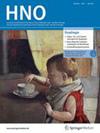下载PDF
{"title":"[骨传导听力系统ADHEAR的临时术后护理©:76例患者的前瞻性研究]。","authors":"C Dreyer, Z Ahmad, Matthias Tisch, E Goldberg-Bockhorn","doi":"10.1007/s00106-025-01548-w","DOIUrl":null,"url":null,"abstract":"<p><strong>Background: </strong>The tamponade applied during ear surgery causes temporary conductive hearing loss with impairment of communication. This can persist until the follow-up procedure (second look, revision) due to insufficient hearing improvement or a prolonged wound healing phase.</p><p><strong>Objective: </strong>This prospective study investigates the subjective and audiological benefit of temporary fitting of a bone conduction hearing aid in patients undergoing ear surgery.</p><p><strong>Materials and methods: </strong>Patients were fitted with the bone conduction hearing system ADHEAR© (MED-EL, Innsbruck, Austria) after ear surgery for the duration of tamponade. A self-developed questionnaire recorded subjective satisfaction with the system. In addition to pre- and postoperative hearing thresholds, speech comprehension was measured in quiet with and without hearing aids after tamponade removal to show the effect of the treatment after tamponade removal in patients with persistent conductive hearing loss.</p><p><strong>Results: </strong>A total of 76 patients were tested and 92% rated the hearing aid as useful during the packed period. More than 60% rated the sound quality as natural and 79% confirmed that they would wear the ADHEAR© again if they had another ear surgery. After packing removal, the air-bone gap was below 10 dB in 66% of patients. On average, speech discrimination improved by 14% in all patients, whereby patients with a persistent sound conduction component ≥ 10 dB (n = 26) achieved the greatest improvement of 25% on average.</p><p><strong>Conclusion: </strong>The results of the study show subjective and audiological benefits with temporary fitting of an adhesive hearing aid to bridge the conductive hearing loss after ear surgery. Continued use of the ADHEAR© could benefit patients with persistent conductive hearing loss until the final fitting appointment (second look, completion of wound healing, revision surgery).</p>","PeriodicalId":55052,"journal":{"name":"Hno","volume":" ","pages":"233-241"},"PeriodicalIF":0.8000,"publicationDate":"2025-04-01","publicationTypes":"Journal Article","fieldsOfStudy":null,"isOpenAccess":false,"openAccessPdf":"https://www.ncbi.nlm.nih.gov/pmc/articles/PMC11926046/pdf/","citationCount":"0","resultStr":"{\"title\":\"[Temporary postoperative care with the bone conduction hearing system ADHEAR© : A prospective study on 76 patients].\",\"authors\":\"C Dreyer, Z Ahmad, Matthias Tisch, E Goldberg-Bockhorn\",\"doi\":\"10.1007/s00106-025-01548-w\",\"DOIUrl\":null,\"url\":null,\"abstract\":\"<p><strong>Background: </strong>The tamponade applied during ear surgery causes temporary conductive hearing loss with impairment of communication. This can persist until the follow-up procedure (second look, revision) due to insufficient hearing improvement or a prolonged wound healing phase.</p><p><strong>Objective: </strong>This prospective study investigates the subjective and audiological benefit of temporary fitting of a bone conduction hearing aid in patients undergoing ear surgery.</p><p><strong>Materials and methods: </strong>Patients were fitted with the bone conduction hearing system ADHEAR© (MED-EL, Innsbruck, Austria) after ear surgery for the duration of tamponade. A self-developed questionnaire recorded subjective satisfaction with the system. In addition to pre- and postoperative hearing thresholds, speech comprehension was measured in quiet with and without hearing aids after tamponade removal to show the effect of the treatment after tamponade removal in patients with persistent conductive hearing loss.</p><p><strong>Results: </strong>A total of 76 patients were tested and 92% rated the hearing aid as useful during the packed period. More than 60% rated the sound quality as natural and 79% confirmed that they would wear the ADHEAR© again if they had another ear surgery. After packing removal, the air-bone gap was below 10 dB in 66% of patients. On average, speech discrimination improved by 14% in all patients, whereby patients with a persistent sound conduction component ≥ 10 dB (n = 26) achieved the greatest improvement of 25% on average.</p><p><strong>Conclusion: </strong>The results of the study show subjective and audiological benefits with temporary fitting of an adhesive hearing aid to bridge the conductive hearing loss after ear surgery. Continued use of the ADHEAR© could benefit patients with persistent conductive hearing loss until the final fitting appointment (second look, completion of wound healing, revision surgery).</p>\",\"PeriodicalId\":55052,\"journal\":{\"name\":\"Hno\",\"volume\":\" \",\"pages\":\"233-241\"},\"PeriodicalIF\":0.8000,\"publicationDate\":\"2025-04-01\",\"publicationTypes\":\"Journal Article\",\"fieldsOfStudy\":null,\"isOpenAccess\":false,\"openAccessPdf\":\"https://www.ncbi.nlm.nih.gov/pmc/articles/PMC11926046/pdf/\",\"citationCount\":\"0\",\"resultStr\":null,\"platform\":\"Semanticscholar\",\"paperid\":null,\"PeriodicalName\":\"Hno\",\"FirstCategoryId\":\"3\",\"ListUrlMain\":\"https://doi.org/10.1007/s00106-025-01548-w\",\"RegionNum\":4,\"RegionCategory\":\"医学\",\"ArticlePicture\":[],\"TitleCN\":null,\"AbstractTextCN\":null,\"PMCID\":null,\"EPubDate\":\"2025/3/11 0:00:00\",\"PubModel\":\"Epub\",\"JCR\":\"Q4\",\"JCRName\":\"OTORHINOLARYNGOLOGY\",\"Score\":null,\"Total\":0}","platform":"Semanticscholar","paperid":null,"PeriodicalName":"Hno","FirstCategoryId":"3","ListUrlMain":"https://doi.org/10.1007/s00106-025-01548-w","RegionNum":4,"RegionCategory":"医学","ArticlePicture":[],"TitleCN":null,"AbstractTextCN":null,"PMCID":null,"EPubDate":"2025/3/11 0:00:00","PubModel":"Epub","JCR":"Q4","JCRName":"OTORHINOLARYNGOLOGY","Score":null,"Total":0}
引用次数: 0
引用
批量引用
[Temporary postoperative care with the bone conduction hearing system ADHEAR© : A prospective study on 76 patients].
Background: The tamponade applied during ear surgery causes temporary conductive hearing loss with impairment of communication. This can persist until the follow-up procedure (second look, revision) due to insufficient hearing improvement or a prolonged wound healing phase.
Objective: This prospective study investigates the subjective and audiological benefit of temporary fitting of a bone conduction hearing aid in patients undergoing ear surgery.
Materials and methods: Patients were fitted with the bone conduction hearing system ADHEAR© (MED-EL, Innsbruck, Austria) after ear surgery for the duration of tamponade. A self-developed questionnaire recorded subjective satisfaction with the system. In addition to pre- and postoperative hearing thresholds, speech comprehension was measured in quiet with and without hearing aids after tamponade removal to show the effect of the treatment after tamponade removal in patients with persistent conductive hearing loss.
Results: A total of 76 patients were tested and 92% rated the hearing aid as useful during the packed period. More than 60% rated the sound quality as natural and 79% confirmed that they would wear the ADHEAR© again if they had another ear surgery. After packing removal, the air-bone gap was below 10 dB in 66% of patients. On average, speech discrimination improved by 14% in all patients, whereby patients with a persistent sound conduction component ≥ 10 dB (n = 26) achieved the greatest improvement of 25% on average.
Conclusion: The results of the study show subjective and audiological benefits with temporary fitting of an adhesive hearing aid to bridge the conductive hearing loss after ear surgery. Continued use of the ADHEAR© could benefit patients with persistent conductive hearing loss until the final fitting appointment (second look, completion of wound healing, revision surgery).

 求助内容:
求助内容: 应助结果提醒方式:
应助结果提醒方式:


